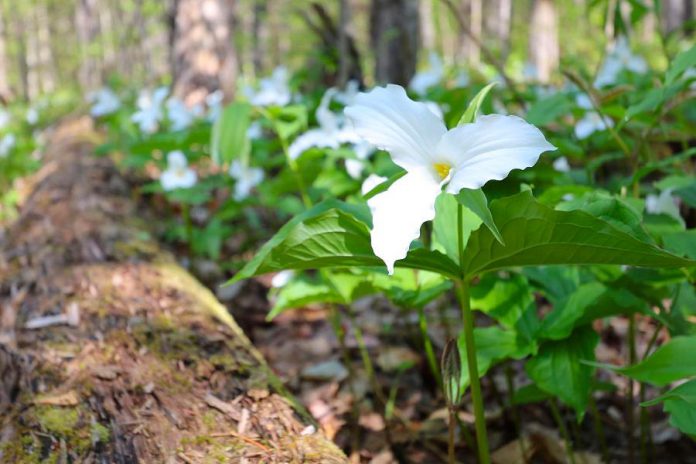
Trilliums are in full bloom in forests and woodlands across Ontario, with many photos of the memorable flower being shared across social media.
People are most familiar with the white trillium (trillium grandiflorum), which is Ontario’s official flower, but there are actually 50 species of trillium native to temperate regions of North America and Asia.
Here are nine things you may not know about trilliums:
1. Trillium roots were once used to treat wounds and during childbirth
The trillium is also known as birthroot or birthwort, because of how the plants were used medicinally.
The roots of several species contain chemical compounds called sapogenins that act as astringents, antiseptics, coagulants, expectorants, and uterine stimulants. North America’s indigenous peoples used the roots to treat open wounds and inflammation, and during childbirth.
Another name for the trillium is the wakerobin — because the flowers appear in early spring before robins begin to appear.
The “tri” in the Latin word trillium means three, referring to the plant’s three leaves, three petals, and three stigmas (pollen receptors) in the flower.
2. If you pick a trillium bloom, the plant may not survive
Although the trillium is a perennial plant, as a spring ephemeral it’s very fragile.
The trillium blooms for a few weeks in the early spring, before the trees grow leaves, so it can get more sunlight. During this time, it collects all the nutrients in needs to survive until the following year.
If you pick the bloom, the plant won’t be able to collect sunlight and nutrients and it may take years to recover — or it may never recover.
3. Contrary to popular belief, it’s not illegal to pick trilliums in Ontario
There’s a pervasive myth that it’s against the law in Ontario to pick trilliums.
The reasons for this belief may be because the trillium is Ontario’s official flower, or because picking the bloom can damage or kill the plant, or maybe because the removal of any vegetation is prohibited in Ontario provincial parks (where trilliums are often found).
In 2009, it did almost became illegal to pick trilliums in Ontario. That’s when former Peterborough-Kawartha MPP and rural affairs minister Jeff Leal introduced a private members’ bill called the Ontario Trillium Protection Act.
That legislation would have made it illegal to pick or dig up the white trillium. Doing so would have resulted in a minimum $500 fine. However, although the bill passed first reading, it never became law.
4. The trillium became Ontario’s official floral emblem in 1937
On March 25, 1937, the Province of Ontario chose the trillium as its official floral emblem (official flower).
The Floral Emblem Act contains a single line: “The flower known botanically as the trillium grandiflorum and popularly known as the white trillium is the floral emblem of the Province of Ontario.”
During the First World War, there was a movement for Canada to choose a national floral emblem — a flower that could be planted on the graves of Canadian servicemen overseas.
A special committee of botanists to the Ontario Horticultural Association recommended the trillium be selected as the national floral emblem. A national flower was never chosen, but Ontario subsequently adopted the trillium for its own provincial flower.
5. The trillium has been the Ontario government’s official logo since 1964
A stylized version of the trillium has been the Ontario government’s official logo since 1964, when it was first created by the Progressive Conservative government of John Robarts.
The original trillium symbol and logotype — an “O” for Ontario with a stylized trillium inside it — was designed by Norman B. Hathaway and Wolfgang Letzin of former Toronto design firm Hathaway-Templeton.
An updated version was designed by Ernst Barenscher at Norman B. Hathaway Associates in 1972, at the request of the Progressive Conservative government of Bill Davis.

Over the next 24 years, the logo pretty much remained the same. Then, in 2006, the Liberal government of Dalton McGuinty completely revamped the logo.
The new logo quickly became known as the “three men in a hot tub” logo — once you see it, you can’t unsee it — and was widely criticized both for its design and cost.
In 2019, the Progressive Conservative government of Doug Ford restored the logo to its original design with some variations.
6. Trilliums have a symbiotic relationship with ants
The seeds of the trillium are mainly distributed by ants, which are attracted to a fleshy structure attached to the seeds called the elaiosome.
The elaiosome is rich with nutrients, which the ants eat after they carry the seeds back to their nests.
The ants then discard the elaiosome-free seeds, either leaving them inside the earth (which protects the seeds from predators) or by ejecting them from their nests. The seeds eventually germinate and sprout into new plants.
This method of seed dispersal by ants is not unique to trilliums — it’s called myrmecochory and is used by many flowering plant species.
7. White-tailed deer love to eat trilliums — especially the white ones
As any gardener in cottage country knows, white-tailed deer love to eat flowers and the trillium is no exception.
The large patches of trilliums that appear in Ontario woodlands in early spring make them a favourite food of the deer.
White-tailed deer are especially partial to the white trillium. They generally only eat the larger flowers, leaving smaller ones behind. The deer also help to disperse trillium seeds, but at much greater distances than ants.
In fact, many Ontario provincial parks use annual trillium surveys to understand the population density of white-tailed deer and their effect on the understory.
8. It takes a trillium plant up to 10 years to produce its first flower
Trilliums are very slow-growing plants.
The plant’s seeds normally take at least two years to fully germinate, with the plant itself taking between seven to 10 years to reach flowering size.
After the plant produces its first flower, it will bloom annually in early spring, with the bloom lasting for around three weeks.
Trilliums are phototropic plants, meaning that the blooms will bend towards the sun as it moves across the sky.
After the first bloom, a trillium will live another 10 to 13 years — but only if you don’t damage them.
9. The drooping trillium is an endangered species in Ontario
There are five native trillium species found in Ontario — the white trillium, red trillium, pinted trillium, nodding trillium, and drooping trillium — but only the latter is endangered.
In Canada, drooping trillium only grows in southwestern Ontario in the warmer climate of the Carolinian forest. There were once six known locations in the province, but today there are only two: along the Sydenham River in Middlesex County and along the Thames River in Elgin County.
The greatest threat to the drooping trillium is habitat loss and degradation caused by urban development, or habitat alteration and damage due to recreational activities such as hiking and ATV use.


























